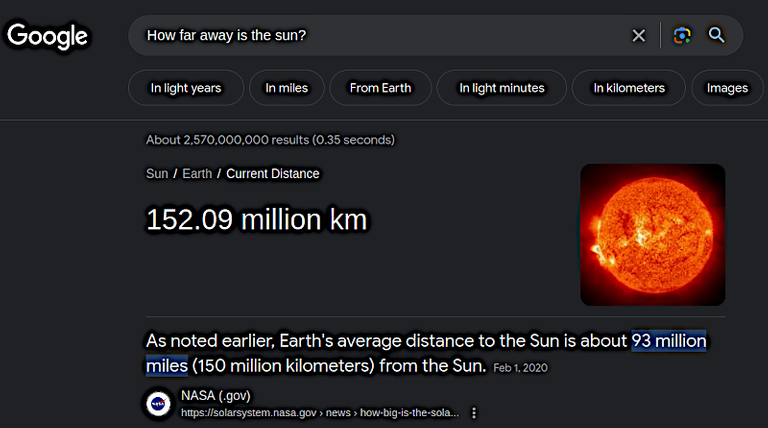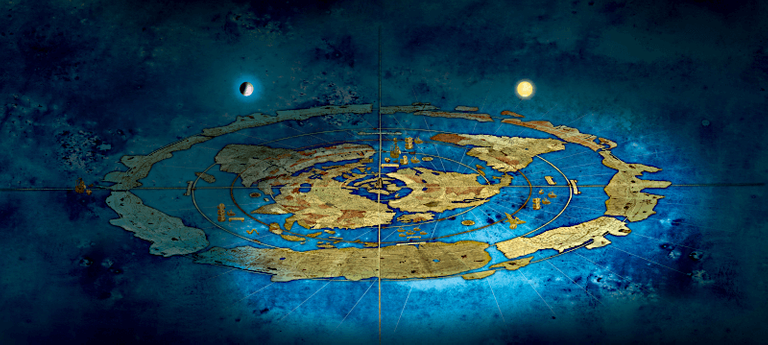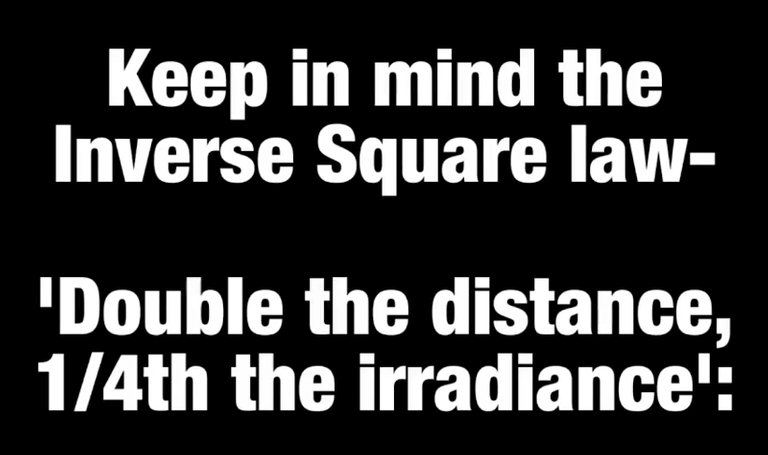The Inverse Square Law (testable, observable, measurable and repeatable) proves that when you double the distance to a light source, you'll only get a quarter of its irradiance.

How far away is the sun?

North at the center. South is all around us:

The sun, moon, wandering stars and zodiacs rotate right above our heads if we live on a "flat, non-rotating earth", just as NASA has documented.


The sun, moon, wandering stars and zodiacs circle right above our heads:

Image sources: Google, NASA and FlatEarthDave.tv
We might be able to see the sun, based on how bright it is supposed to be, but there is no way would could see stars. The probability of you standing in the right place to intercept one of its photons is infinitesimally small. Even if it is putting out billions of photons a second.
We have a lot to learn about where we live. And NASA is not helping.
Yes indeed, let alone the stars' lack of parallax. NASA has some splainin' to do.
You forgot the other part of the math equation: The size of the sun.
The size of the sun is 1392000 kilometers across, and as for distance, 1520000 km.
To calculate how much smaller things become by distance, you can use the angular size formula. I found an online calculator that would do the math, and the final result is 5.24 degrees.
https://sizecalc.com/
Well, that's 5 degrees of the sky that the sun should take up then, and that's about how it looks any time I look upwards. As for the inverse law, you'd be right, except that our eye is a lens, and takes all the light it receives across the entire surface, and focuses it onto a single point: The retina.
Right, that's what NASA, Google, Schools, et al tells us, but how could the lens of their telescope have enabled us to measure the size, or the distance of an object that is supposedly 93 Million miles away?
How do they know it's not 91 Million miles? Or just 1 Million miles?
I can fill the viewfinder of my camera by zooming in on a stop sign a mile away too, but that doesn't tell me its size, or its distance.
So, how do you know the size and distance of the sun? I'm not trying to be a smartass, I really don't know. Did they bounce a radio signal off of it, or shoot a laser at it or something? I mean I suppose that would give you the distance if that was possible.
Loathe as I am to get involved in pointless discussions when people don't want to know the answers, I expect you would struggle to bounce anything off the sun as it is giving out massive amounts of light that would swamp your laser. It would work with the Moon though.
Calculating the distance to the Sun requires careful, accurate observations, but then it's just geometry. The ancient Greeks had a go, but lacked the former.
https://www.universetoday.com/117843/how-did-we-find-the-distance-to-the-sun/
https://www.space.com/17081-how-far-is-earth-from-the-sun.html
I expect thousands of astronomers have taken measurements that will confirm the numbers. The distance does vary as our orbit is not a perfect circle. That was known hundreds of years ago.
We can see the Sun because it is so freaking enormous, as are the stars.
You say you hate maths, but just because you don't understand something does not make it untrue. If you make outrageous claims then you need extraordinary evidence and there are knock-on effects, e.g. if the Sun is close and small then how does it stay hot and what keeps it up? You may do down the concept of theory of gravity, but in science a theory needs to be tested and that one has been for hundreds of years. There have just been minor adjustments for things like relativity which come into play in extreme conditions. Newton got a lot right.
But believe what you want. The engineers and scientists will rely on real evidence.
That's true, but with the scientific method, we also need to complete the rest of the equation. Testable, observable (i see a circle up there, not a sphere), measurable and repeatable.
So, since observations are not actually measuring the distance or the size, how did they come up with the number 93 Million and not 1 Billion or a hundred thousand? A laser? A bounced radio signal?
You do know people have special telescopes that can look at the Sun? Please don't try it yourself or you will go blind. They can see how it curves. The Sun has features. I don't expect you will believe in the probes that have been sent to take a closer look, but I can't be arsed to try and convince you.
I have not looked into the exact details of the measurement, but thousands of astronomers have. Compare that to the few 'sceptics' who have done zero calculations, but think 'it does not seem right'.
This is a pointless exercise if you have already set your mind.
I'm off on a long flight next month. I hope we don't accidentally go over the edge!
Take it easy.
No legit flat earther believes that we are on some sort of disc floating in a space void/vacuum, or able to fall off an edge. That's "Flat Earth Society" bs.
It is not "pointless" to try and prove the actual variables in an equation. "Thousands of scientists", even those whom are "Peer Reviewed" can be wrong. Without a way to measure the distance with a laser, radio signal, etc, then all you have is a theory.
So if you really want to engage in this conversation, I implore you to give me one single proof of the distance, using the Scientific Method.
If you live in Australia and I live in Argentina, can you point a laser or shoot a radio signal at me and tell me the size and distance from you of the ball that I am holding up?
Without knowing what you believe or your qualifications for proof this is a pointless discussion. You can look up scientific papers on such matters, but may not understand them. I'm not an expert on these topics, but I trust others to be. If you lack trust then life gets difficult.
You cannot measure everything with a laser, especially as they only go in straight lines, not around spheres.
But it does. Should be relatively easy mathematics, and depends on the magnification factor of your lens and the distance you would be able to fill the STOP sign from when using the shortest focal length of the lens.
Say if you can fill the viewfinder at 2 meters with a 75-300mm lens at 75mm, you should be able to multiply the distance with the zoom factor, which in that case would be 4.
So here's a real-life example, I took two photos of a smallish painting (sized 33cm × 20cm) in my flat, filling the viewfinder at 300mm and 75mm, and it checks out. At 300mm I was 5 meters away, and when shooting at 75mm, the distance was only 1.20m.
For copyright reasons I can't post the photos of the paintings, but you can actually try it out yourself. Calculate the zoom factor of your lens by dividing the longest focal length with the shortest of your lens, then apply that when shooting the stop sign. In my case, if the mile-away STOP sign filled out the viewfinder, I would just divide the distance by 4, and find out I should walk three quarters of a mile closer to fill the viewfinder at 75mm.
Oh, and also that the STOP sign is really huge.
Edit: If you want to know the actual size of the STOP sign, you can do that too. Shoot something that you know the size of, by filling the viewfinder, then apply those measurements and the distance you shot it in, to calculate the size of the STOP sign.
If you hate basic math like I do, this 4 minute video explains it way better than I can:
https://flatearthdave.tv/w/cYCGHNojvgCUtsS4dRWEC2
Hmm
I thought we usually see the stars dazzling in the sky every night. Am I right?
Yep, I do.
I've come to learn that we essentially live on a huge, battery-powered clock. A perfect timepiece. The sun tracks the hours, the moon tracks the months and the stars track the seasons. Just like this: https://flatearthdave.tv/w/5CFDzPVAzsbMCGNdN34kTk
Who changes the batteries?
No need. The earth, the oceans, the torroidal electro-magnetic and electro-static energy that surrounds us is the perfect self-regenerating battery.
Imagine you live on a flat earth as depicted in the images above. The clock works perfectly.
But I thought you didn't believe in a flat earth?
I think you're just messing with me. If not then we have stalemate. I'll enjoy the wonders of science.
I'm not messing with you Steve, you came into this conversation because you disagree with my viewpoints and wanted to let me know. That's awesome man and I do appreciate a good debate. My beliefs are seemingly fringe, I know that, but I don't care. I seek out truth. Provable facts. If I just trusted my belief like you are doing, then I might be a bible thumping Christian or something which I am not (no offense if you're a bible thumping Christian).
As for the shape of the world that we live on.. I no longer believe that we live on a spinning ball in an impossible space void/vacuum surrounded by evermore spinning balls, that's for sure. :)
You're making too much sense, let's go back to watching Star Trek. That's is much more trustworthy than math. :-) !LOLZ
lolztoken.com
but then I changed my mind.
Credit: marshmellowman
@kencode, I sent you an $LOLZ on behalf of ironshield
(2/10)
ENTER @WIN.HIVE'S DAILY DRAW AND WIN HIVE!
I believe the sun is inside the firmament.
I believe it is within, or just outside of the firmament because of the shape of the light that is cast over the surface of our known plane-t. Turn a big glass bowl upside down on a table, turn out the lights, put a flashlight just outside the bowl and circle that flashlight into the bowl just outside of the bowl and watch the shape of the light that is cast into the area under the bowl. That shape seems to match the light shapes that we can see. Sometimes the light is circular, sometimes it becomes oblong. Crrow777 has some awesome demonstrations of this which also make a lot of sense.
Hmm, interesting. Perhaps that explains 24 sun in the outer circle? Something to investigate.
I always thought the sun must be inside and distant from the firmament since the firmament remains unlit (black) behind the sun, while the earth is lit (blue). This seems to indicate that the sun is closer to the earth than the firmament.
When I realized that EAST/WEST is not a straight line like NORTH/SOUTH is, that changed my perspective on everything. Following the compass EAST will require you to turn slightly to the left to stay going EAST. Following the compass WEST will require you to turn slightly to the right to stay on course. Traveling due EAST or WEST without adjusting to the "curvature" will eventually take you off course to the SOUTH.
It's claimed that if you follow a compass south, then east, then north you'll end up where you began. This is true, but does not prove a ball. The reality is that North will always lead to a central point, south always leads away from that central point, and east (and west) will always circle around that central point. Straight south, curved east, straight north - like a slice of !PIZZA.
This is how I overcame the pacman map view of the world, which didn't make any sense at all. I assumed EAST/WEST were a straight line and a person would teleport to the other side. Going "around the world" by going EAST or WEST, completing a circle, makes a lot more sense to me now. !LOLZ
lolztoken.com
A taxidermist takes only your skin.
Credit: reddit
@kencode, I sent you an $LOLZ on behalf of ironshield
(1/10)
ENTER @WIN.HIVE'S DAILY DRAW AND WIN HIVE!
Exactly.
NASA tells us the curve equation is 8 inches of drop per mile, squared. So, iirc, a 6 foot person standing at the edge of a large lake should not be able to see the surface of the water any further than 3 miles away. Yet with a basic camera, we can. Basic math with the proper variables in the equation gives us correct answers and proofs, not just beliefs.
Need a t-shirt with 8" per mile ^2 written on it, just to remind everyone of their own beliefs, if they ever decided to prove the "crazy ones" wrong. Alleged stories and photographs and urban legends and myths do not change the reality we experience every day. The only curvature anyone can find outside of one's own imagination, is inside a fish-eye lens.
$PIZZA slices delivered:
@ironshield(1/5) tipped @kencode
I guess that officially makes @kencode a member of you exclusive and private conspiracy theorists circle jerk community then.
Before you do what @lasseehlers suggests @kencode here is a word of advice:
Go to https://www.lassecash.com/created first and scroll down. Look at what the reward payouts in Lassecash are actually like. You'll see very few posts actually get much of that token.
https://www.lassecash.com is @lasseehlers' own personal circle jerk community in which @lasseehlers upvotes only himself and a few of his friends. Hive users tend to look down on circle jerk upvoting for posts. @lasseehlers is already a flat earther with a low reputation score for things like that. The Hive platform doesn't need another one.